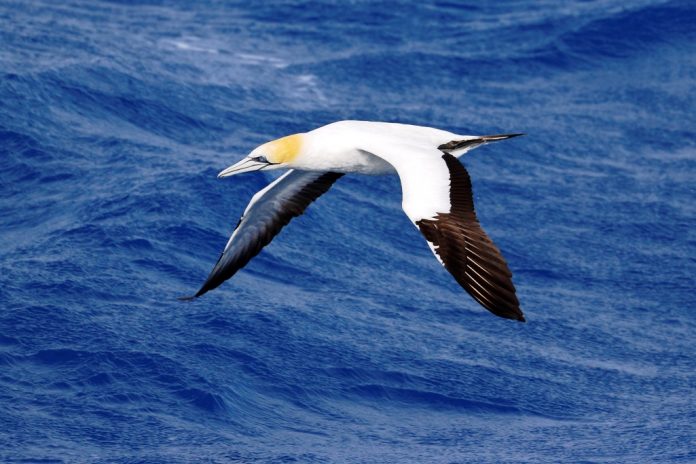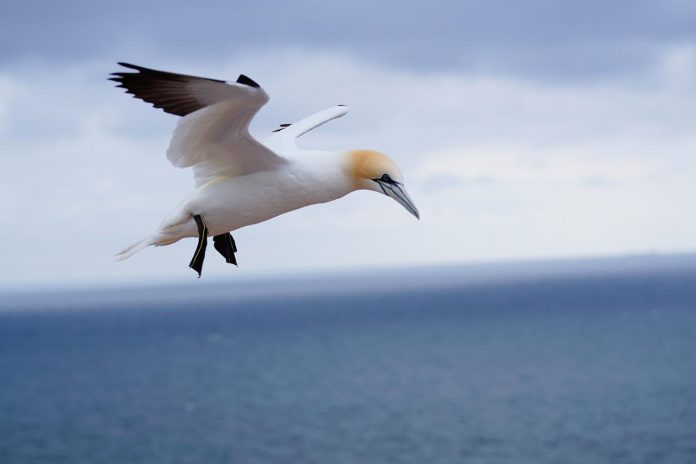The fishing technique of the sea-going Australasian gannets is spectacular. They patrol along, then suddenly plunge into the water from 10 meters or more, with their wings folded back to form a living arrowhead. Air sacs in the body cushion the impact of the sea, the nictitating membrane covers the eye involuntarily, and the nostrils are occluded to keep water out. Out of the water, gannets breathe through the corners of the mouth.
Australasian Gannet frequently forages in small flocks, effectively herding the fish. Some birds will dive while others are rising, and yet others are swimming. Shoaling fish are their quarry, and they catch them not by spearing but by diving beneath, turning, and grasping them on their way back to the surface. The margins of the bill have fine, reversed serrations for holding fish firmly.
Gannets hardly ever stay underwater for longer than 12 seconds and habitually swallow the fish during this time. Alternating a few leisurely flaps with long glides, Australasian gannets are graceful fliers and can wheel against the wind on barely moving wings.
They sleep at sea and are silent there, which contrasts starkly with the cackling that rises as a daily roar from their dense breeding colonies. Like the boobies, they are day-active at their colonies, but they have rather different displays. When touching down, the crane goes up and down; bounces up in the air, and lands a meter or so away to be inhaled by bellows.
As the pair greet, facing one another, they stretch and shake their heads from side to side, wings angled out and bills sometimes clashing, falling into a deep bow. Mutual preening and further bowing may continue until the relieved bird is ready to depart. Australian Gannets pair for life, and in courtship, the male raises its wings and points its bill skyward, in much the same way as male boobies do when advertising for a mate.
Unlike them, the male gannets are nape-bitten females in copulation and tramp with their feet. In the colony, nests are evenly spaced about a meter apart, signifying the extent of each pair’s territory. Eggs are laid through October and hatch over January-February. Young is first brooded by both adults in 12-hour shifts until well-downed and fledged by desertion in late April-early May.
They may return to the rookery at the age of three, but they are not able to begin breeding until they are six or seven years old. The size of the Australasian Gannet is about 840–920 mm in length. Both sexes are similar. The general body plumage is white with a buff head and black primaries, secondaries, and inner tail feathers. It has a concealed slate-blue throat stripe. The eyes are light gray, and the bill is blue-gray.
The feet are black with yellow-green stripes on toes and a scutellate front of the lower ‘leg’; the webs are brown. The immature general body plumage is an irregular mixture of white and gray-brown with a dark tail. The upper parts of the body are mainly dusky, mottled white; the underparts are mainly white, grayish on the neck. The downy young are naked, then white-downed.
The displayed calls of Australasian Gannet are at the nest of a loud, repetitive cackling urrah. The voice of males has a slightly higher pitch than that of females. Departing birds cackle, erk-erk-erk, snort, and quack in flight and fight. Young grunt and chirp. The nesting and breeding are in October and May. Nest an earth mound of guano and debris about 250 mm high, on the ground or on a man-made platform, in colonies. Normally, one egg is white; that is, oblong-oval, at the size of about 78 x 48 mm.
The incubation period is about 44–48 days for both parents in 28-hour shifts, clasping the egg in their webbed feet. The young fledged in 94–106 days. Both parents take care of the young and provide food. The distribution of Australasian Gannet is in temperate waters along the coasts of southern Australia, including Tasmania.
There are a few breeds on islands off Victoria, such as Lawrence Rocks, and isolated rocks off Tasmania. Most of the population breeds on rocks and headlands around the main islands of New Zealand. The general westward is dispersal in winter and by non-breeding birds, extending to Western Australia and rarely even Africa; breeders are more sedentary.
Read More: Wandering Albatross – The Largest Flying Bird




